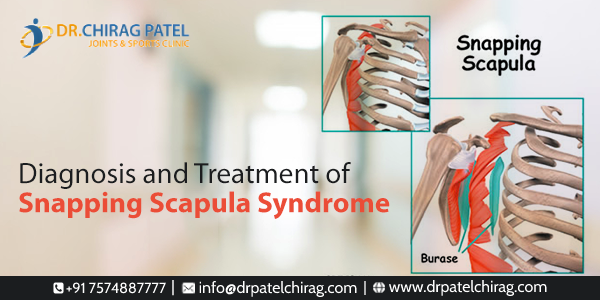The snapping scapula syndrome, also known as the washboard syndrome is the popping or snapping of the bones and tissues located in the scapula-thoracic joint during its movement. It is mainly caused by the bursitis of the shoulder joint and abnormalities in the muscles and soft tissues surrounding it.
The curvature of the joint’s superomedial border is responsible for this condition. The first question that arises in the minds of people is “Is snapping scapula syndrome dangerous?”
Diagnosis of Snapping Scapula Syndrome
- Visible symptoms: Snapping scapula syndrome is characterized by a loud pop or cracks during the overhead abduction of the arm. The motion of the shoulder is also greatly compromised. There is also an altered movement of the scapula over the thoracic wall. Other visible symptoms are postural changes, a change in the normal scapula-humeral rhythm and a positional asymmetry.
- Methods of diagnosis: The diagnosis of the snapping scapula syndrome is facilitated by the use of scans such as X-rays, three-dimensional CT scans, MRIs and ultrasound scans. MRIs provide the best look at the soft tissues, thereby increasing the ease of diagnosis. Ultrasound comes into utilization when bursitis or the inflammation of the capsular bursa around the shoulder joint is involved, which again requires advanced treatment methods.
Local anaesthetics and injections are also administered to identify possible bursitis. These are injected at the point of maximum tenderness or the snapping scapula syndrome pain location.
Medial scapular border tenderness, palpable crepitus, and audible popping sounds are the most conspicuous clinical signs found.
Treatment of Snapping Scapula Syndrome
- Non-operative methods of treatment:
Physiotherapists play a key role in this type of treatment. Postural issues are addressed and exercises are recommended to ensure that the head, neck, and shoulders line up and function in a coordinated manner with the other bones of the body.
In severe cases, the kinetic chain rehab model is also employed, where the dynamic scapular control and muscle endurance are restored. Efforts are also made to restore the glenohumeral ratio to its normal value of 2:1. These treatments are available in the best sports clinic in Mumbai.
- Operative or surgical methods of treatment:
When non-surgical treatments fail, operative methods of treatment are suggested. These surgeries can be performed by the best bone specialist doctor in Mumbai. A portion of the scapula that presses against the rib cage may be removed in a process known as scapular dissection.
Surgery of the rotator cuff muscles around the shoulder joint, namely Subscapularis, Infraspinatus, Teres minor and Supraspinatus may also be suggested. Those requiring a rotator cuff surgery in Mumbai are advised to consult experienced and competent doctors like Dr. Chirag Patel for the same.
Doctor Chirag Patel is a qualified orthopaedic surgeon practicing in Mumbai, India who specializes in the treatment of orthopaedic disorders, especially of the hip and the knee joint. He has trained at several renowned centers in Australia, the United States of America and Europe. He has undertaken fellowships in adult hip & knee reconstructive surgery, arthroplasty and keyhole surgeries.





